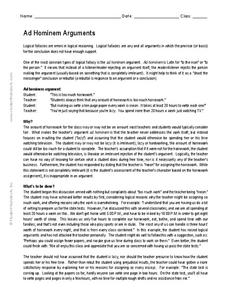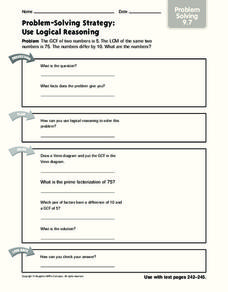Curated OER
Problem-Solving Strategy: Use Logical Reasoning
In this problem solving worksheet, students use logical reasoning to solve each of 4 problems. The word problems pertain to the position of people in line, theater seating and identification of who plays what instrument in a talent show.
Curated OER
Problem-Solving Strategy: Use Logical Reasoning Practice 13.4
In this problem solving strategy worksheet, learners read 3 different story problems. Students use logical reasoning to solve.
Curated OER
Problem-Solving Strategy: Use Logical Reasoning
In this logical reasoning worksheet, 4th graders read a paragraph about what three students are brought for lunch before determining what each student eats through logical reasoning. They record what they understand, make a plan, fill in...
Student Handouts
Ad Hominem Arguments
Give your class a lesson in logical reasoning. This learning exercise, which focuses on ad hominem arguments, goes step by step through an example. After examining the argument, learners assess a second conversation for ad hominem...
Curated OER
Using Logical Reasoning
In this geometry worksheet, 10th graders analyze and solve logic puzzles. The one page interactive worksheet contains five multiple choice questions, provides a hint, and is self checking.
Student Handouts
Logical Fallacies
Help your learners grow their critical thinking and analytical skills by asking them to examine logical fallacies. After reading an example, pupils determine if two sets of premises and conclusions are logical fallacies or not and...
Curated OER
Problem-Solving Strategy: Use Logical Reasoning
In this logical reasoning worksheet, students utilize the problem-solving strategy of logical reasoning to answer 2 short answer mathematical questions.
Curated OER
Problem-Solving Strategy: Use Logical Reasoning, Practice
In this logical reasoning worksheet, 2nd graders solve 3 word problems, showing their work. Reference to a Houghton Mifflin text is given.
Curated OER
Problem-Solving Strategy: Use Logical Reasoning
In this problem-solving worksheet, students solve 1 mathematical word problem by figuring out the answers to 7 questions. Students record their answers on the lines provided.
Curated OER
Problem-Solving Strategy: Use Logical Reasoning homework 3.3
In this using logical reasoning to solve word problems worksheet, students use the logical reasoning problem solving strategy of drawing a table to solve word problems. Students solve two problems.
Curated OER
Problem Solving: Use Logical Reasoning challenge
In this sorting activity, students use logical reasoning to identify a sorting rule for each set of two pictures and draw a third item that belongs in each group. Students draw four pictures.
Curated OER
"The Story of an Hour" Lesson 5: Teacher's Guide and Notes
Learning how to craft a compelling argument supported by evidence and logical reasoning is an essential skill. The fifth lesson in "The Story of An Hour" unit asks young scholars to formulate an argument in response to the question, 'Is...
Curated OER
Problem Solving: Strategy: Use Logical Reasoning
In this problem solving strategy activity, 6th graders solve a story problem using the strategies of understand, plan, solve, and look back.
Curated OER
Problem Solving: Logical Reasoning problem solving 13.4
In this problem solving with logical reasoning activity, students read a word problem and write short answers to show the steps for understanding, planning, solving, and checking. Students write four short answers.
Curated OER
Problem Solving Strategy: Logical Reasoning
For this problem solving strategy worksheet, students solve 6 math word problems that require them to use logical reasoning skills.
Curated OER
Challenge: Logical Reasoning-Working With Tables
In this logical reasoning worksheet, students write yes or no about the number of teeth various animals have, completing a table to solve 5 questions, then read a set of clues and draw a table to solve 6 questions.
Curated OER
Lesson: Proposal for a School Sculpture
After discussing the artistic elements and design process needed to construct the modern sculpture, Lao Tzu, kids get logical. They consider the purposeful use of space in the sculpture, design a modern piece for a specific space at...
Virginia Department of Education
Inductive and Deductive Reasoning
Introduce pupils to the two types of reasoning, inductive and deductive. Classmates work in pairs or small groups to learn the difference between the two and apply these reasonings to develop valid conclusions.
Texas Education Agency (TEA)
Evaluating the Effectiveness of Arguments, i.e., Identify Fallacies (English III Reading)
A series of interactive exercises provide users with the ammunition they need to detect logical fallacies and defend themselves against persuasion. Learners read about 11 types of logical fallacies and identify the type used in sample...
Scouts
The Deadly Picnic: A Lab on Deductive Reasoning
Whodunnit? Find out who killed Mr. Brooks through a logical examination of evidence. Class members fill out a couple of data tables to help them pin down the suspect. After they've figured out just who the culprit is, pupils compose...
Curated OER
Inductive and Deductive Reasoning
High schoolers use logical arguments and inductive reasoning to make or disprove conjectures. After observing a teacher led demonstration, students discover that the deductive process narrows facts to a few possible conclusions. In...
Curated OER
Problem-Solving Strategy: Use Logical Reasoning
In this problem solving strategies learning exercise, students use logical reasoning to understand, plan, solve, and look back at a word problem.
Curated OER
Sunshine Math - 3
In this mixed review math worksheet, students answer 1 multiple choice question using logical reasoning. Then students answer 1 fill in the blank problem on probability. Next, students answer 1 fill in the blank question on place...
Curated OER
Use Logical Reasoning
In this logical reasoning, students figure out in what order to place four different shapes by reading the clues. Students solve the problem by drawing the shapes in the correct order.

























